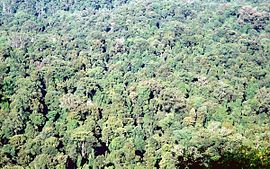Toonumbar National Park
|
Toonumbar National Park New South Wales |
|
|---|---|
|
IUCN category II (national park)
|
|

Tall sub tropical rainforest at Toonumbar National Park
|
|
| Nearest town or city | Woodenbong |
| Coordinates | 28°29′16″S 152°43′33″E / 28.48778°S 152.72583°ECoordinates: 28°29′16″S 152°43′33″E / 28.48778°S 152.72583°E |
| Established | 22 December 1995 |
| Area | 149.1 km2 (57.6 sq mi) |
| Managing authorities | NSW National Parks & Wildlife Service |
| Website | Toonumbar National Park |
| See also | Protected areas of New South Wales |
The Toonumbar National Park is a protected national park located in the Northern Rivers region of New South Wales, Australia. The 14,910-hectare (36,800-acre) park is situated approximately 620 kilometres (390 mi) north of Sydney, near the town of Woodenbong.
The park is part of the Focal Peak Group World Heritage Site Gondwana Rainforests of Australia inscribed in 1986 and added to the Australian National Heritage List in 2007.
The park features subtropical rainforests protecting threatened plants and animals, such as the sooty owl, red-legged pademelon and yellow-bellied glider. The rainforests on Dome Mountain and the Murray Scrub are part of the World Heritage listed Gondwana Rainforests of Australia. The rugged landscape of Mount Lindesay, Dome Mountain and Edinburgh Castle have provided the inspiration for many local Aboriginal legends.
The Murray Scrub and the Dome Mountain Forest contain significant areas of subtropical and temperate rainforest and are listed as part of the World Heritage Gondwana Rainforests of Australia. There are also drier and cooler places in the park and this has resulted in incredible diversity of flora, from eucalypt woodlands and tall gum forests, to forests of bangalow palms.
Animals in the park include marbled frogmouth, koala, Albert lyrebird and rainforest reptiles and frogs. The rainforest area is an important refuge for a number of fruit-eating pigeons and insectivorous bats. Pademelons also live there.
...
Wikipedia

